Physical Address
304 North Cardinal St.
Dorchester Center, MA 02124
A sudden persistent neurological deficit of vascular origin
Large vessel thromboembolic stroke (40%)
Most commonly due to thrombus at the site of atherosclerotic plaque or embolization more distally ▸ sites: carotid bifurcation > intracranial internal carotid artery (ICA) > proximal MCA (> anterior cerebral artery (ACA)) ▸ vertebral artery origins > distal vertebral artery (VA) > basilar artery
Vasculopathy (dissection / FMD / vasculitis)
Haematological (rotein C deficiency / pregnancy / OCP)
Cardioembolic stroke (15–30%)
Intracardiac thrombu or tumour / valvular disease / cardiac
Small vessel / lacunar stroke (15–30%)
Deep white matter infarcts are typically small vessel in nature ▸ MCA territory infarcts can arise from emboli from the heart or carotid artery, or from in situ MCA thrombosis ▸ small peripheral infarcts in a vascular territory are usually embolic
By definition this describes neurology resolving within 24 hours (including amaurosis fugax)
This describes a peripheral rim of underperfused salvageable ischaemic tissue (surrounding already infarcted tissue) ▸ it is liable to infarct without prompt intervention
Large core infarcts (70 ml) have a poor outcome regardless of penumbra characteristics
‘Matched’ defects (core infarct with a small penumbra) have reduced reperfusion benefit ▸ ‘mis-matched’ defects (large areas of salvageable tissue – penumbra >20% of core) are likely to benefit ▸ patient selection using penumbral imaging may extend therapeutic window >4.5 hrs
This occurs at the boundaries of major vessel territories, possibly due to global hypoperfusion (e.g. between collaterals of the MCA / ACA and MCA / PCA) ▸ uncommon in the posterior fossa
These cause infarcts of an entire arterial territory (unless a sufficient collateral circulation exists, in which case there may be deep infarcts with sparing of the overlying cortex)
These cause cortical peripheral wedge-shaped infarcts
These cause lacunar infarcts
Most carotid territory infarcts involve the middle cerebral artery
The anterior cerebral artery (ACA) collateral flow is generally excellent and emboli are relatively rare ▸ the commonest cause of an ACA infarct is vasospasm following a subarachnoid haemorrhage
Brainstem infarcts: these are commonly due to occlusion of a short perforating vessel
‘Top of the basilar’ syndrome: a combination of an infratentorial, thalamic and occipital infarct suggesting a distal basilar arterial occlusion
Multiple infarcts within different arterial territories suggest a cardiac rather than a carotid embolic source (or a haemodynamic hypotensive stroke if the distribution conforms to the arterial border ‘watershed’ zones)
Diagnostic imaging plays an important role as an ischaemic or haemorrhagic stroke cannot be distinguished clinically (and also around 30% of stroke-like episodes have a nonvascular cause)
This allows exclusion of a haemorrhagic stroke, allowing rapid tPA administration ▸ can exclude an underlying mass or AVM
Determine size of core infarct ± penumbra salvageable tissue
Assessment of suitability for thrombolytic therapy in cases presenting at 3–6 hrs, or in cases with an unclear time of onset (tissue infarcted <3 hrs normal: subtly abnormal on FLAIR, tissue infarcted >4.5 hrs: hyperintense on FLAIR)
Assessing clinically severe strokes to determine whether the deficit can be accounted for by a large area of reversible ischaemia
If considering mechanical thrombectomy as a rescue therapy if IV treatment failed
This is usually the first-line investigation and is more widely available outside routine working hours
MRI: this is better at showing the extent of the ischaemic change
DWI: this is more sensitive for early infarcts, demonstrating a new infarct on a background of chronic ischaemic damage, or for diagnosing a TIA
These allow a full assessment of the arterial tree from the aortic arch to the circle of Willis ▸ identifies embolic sources ▸ excludes dissection ▸ assesses potential for intra arterial thrombolysis / endovascular mechanical embolectomy (acute stroke therapy)
Will not clearly show arterial segments that are anatomically inaccessible or heavily calcified
Surgical candidates: a symptomatic (70–99%) stenosis of the internal carotid artery
IV thrombolysis (tPA) can be given (criteria: haemorrhage excluded / <4.5 h of onset / infarct < ![]() MCA territory / <80 years old) ▸ intra-arterial thrombolysis or endovascular mechanical embolectomy
MCA territory / <80 years old) ▸ intra-arterial thrombolysis or endovascular mechanical embolectomy
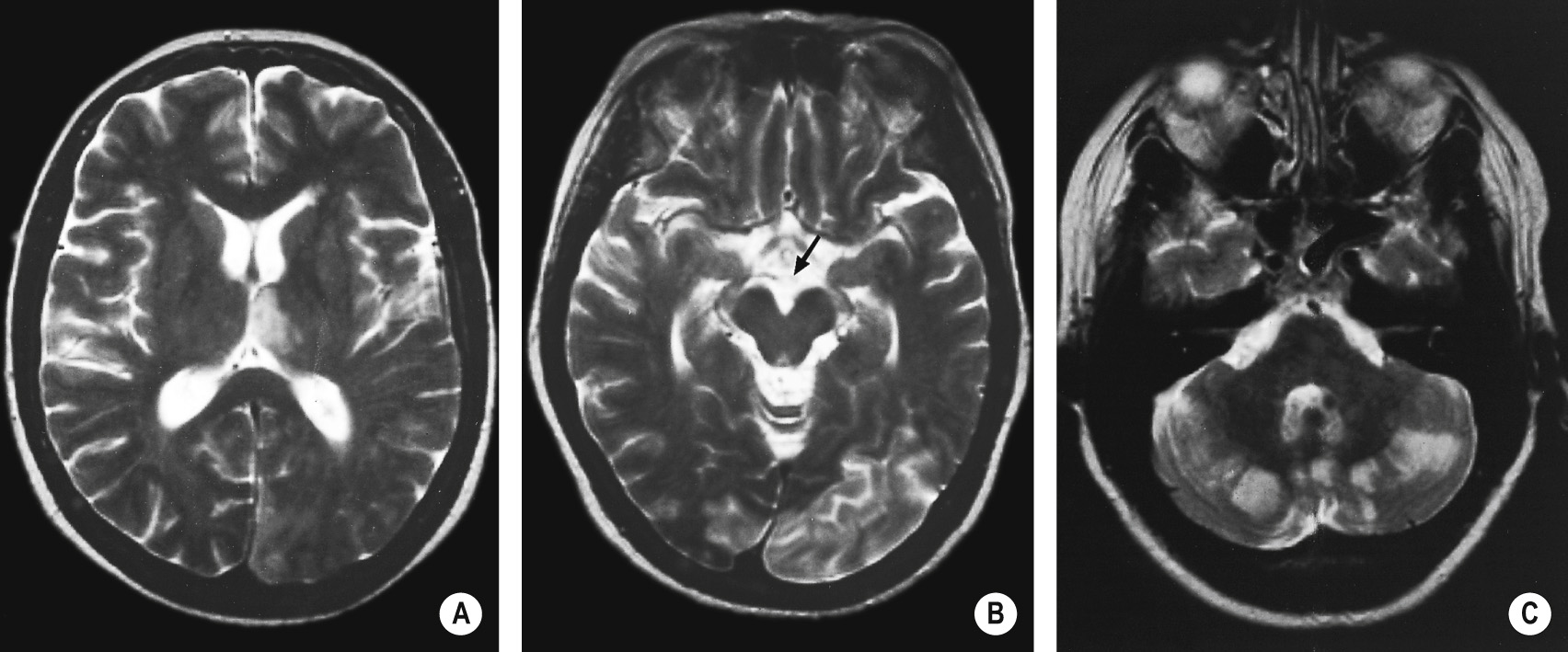
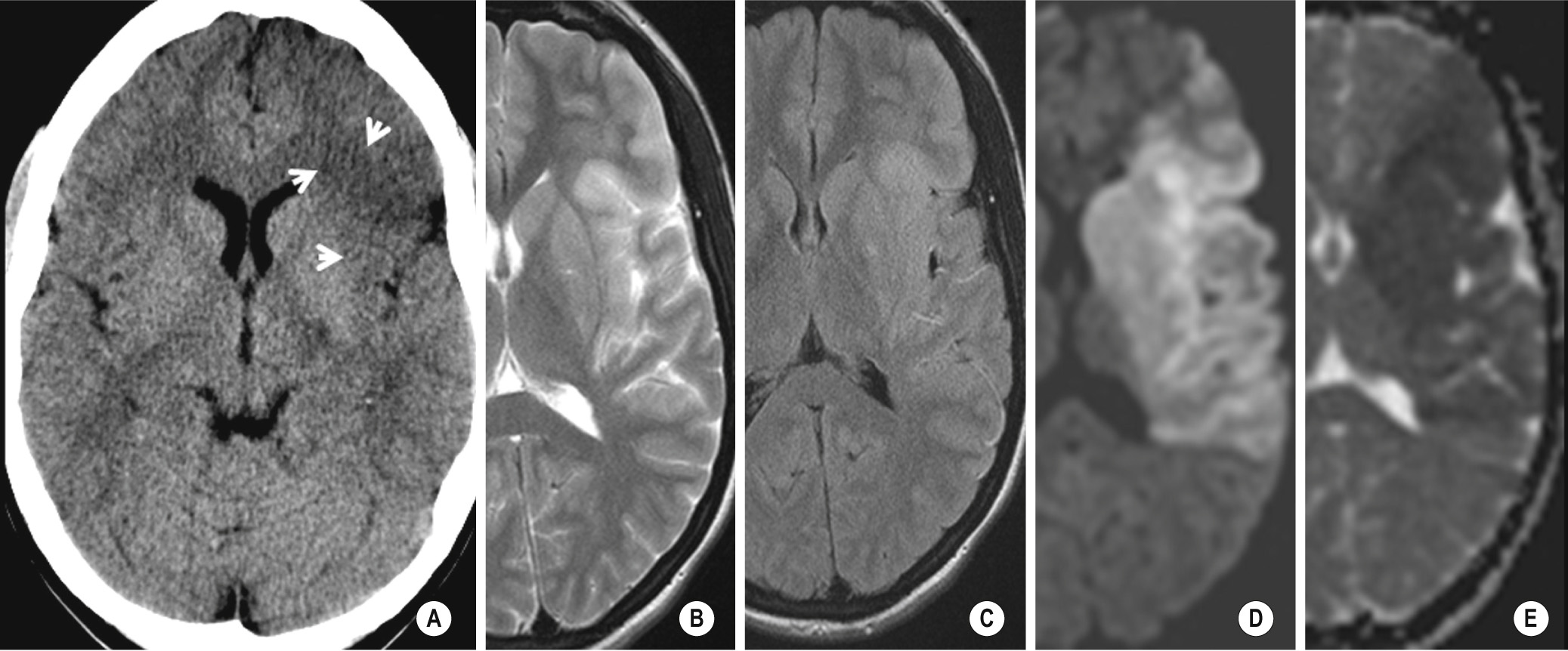
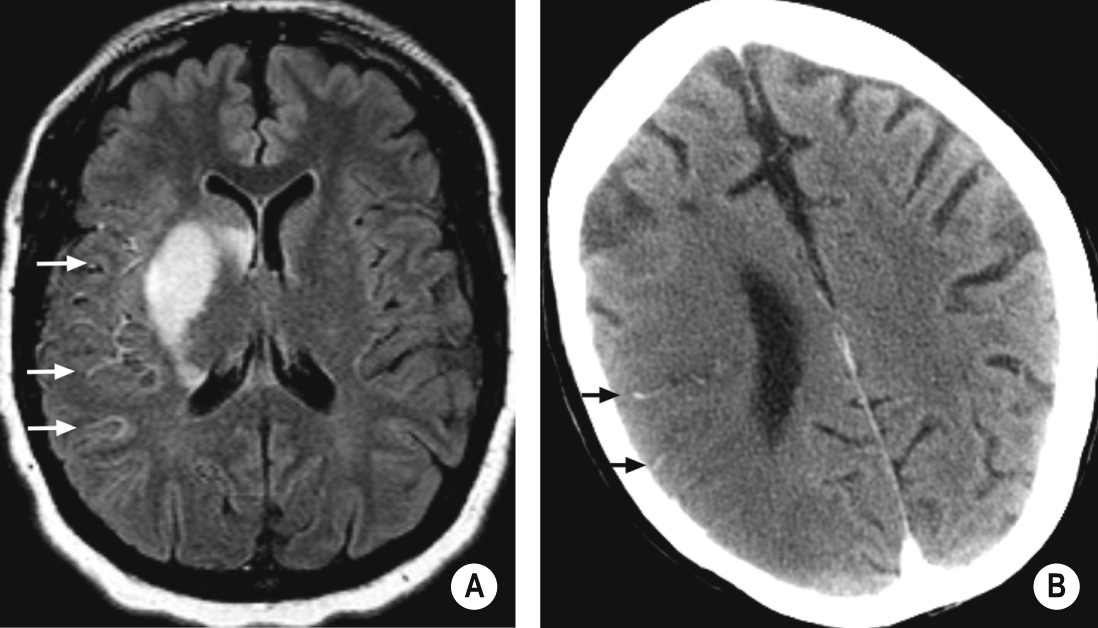
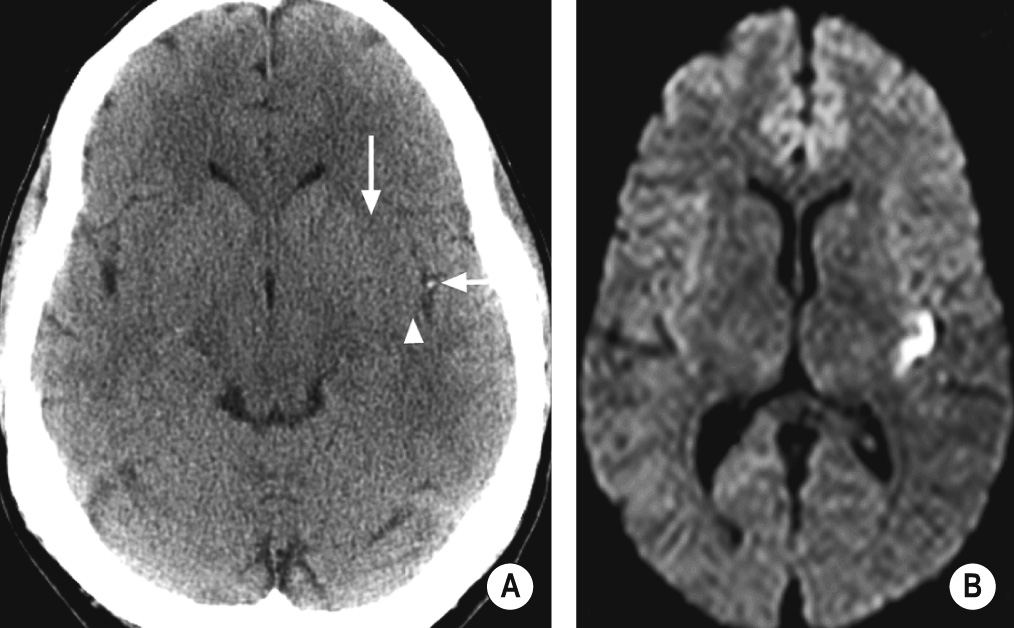
Poor sensitivity for infarcts – consider using the ASPECTS scoring system
Earliest detectable change : the ‘dense artery’ sign: this is due to fresh thrombus occluding a vessel (as thrombus can rapidly disperse this sign is not always present) ▸ if this is seen within the proximal MCA it correlates with a large infarct ▸ better prognosis if within MCA branch within sylvian fissue (sylvian fissure ‘dot’ sign)
MCA calcification can also mimic this sign but it is often bilateral ▸ the basilar artery may also appear dense (particularly in the ‘top of basilar’ syndrome)
Early parenchymal signs :
Cytotoxic oedema: reduced grey matter density ▸ brain swelling (sulcal effacement)
Early MCA infarcts: a reduction in the clarity of the lentiform nucleus and cortex (particularly the insula) ▸ >50% involvement of MCA territory has a high mortality rate
‘Insular ribbon’ sign: this is demonstrated if the insular cortex is involved
Late signs : encephalomalacia and atrophy with enlargement of the adjacent sulci and ventricles
A region of swelling without an area of associated low density (resulting from a compensatory increase in CBV) can be a sign of compromised perfusion that may be reversible
CT is much more sensitive than MRI for detecting acute haemorrhage
Early changes: thrombus can cause loss of the normal arterial flow void (arterial high SI may be seen with FLAIR imaging due to altered flow – this is a useful qualitative sign of reduced perfusion when the parenchyma still appears normal)
Early parenchymal signs : there is structural breakdown and disruption of the blood-brain barrier with fluid leaking into the extracellular space ▸ this manifests as cortical swelling and T1/T2 prolongation (this is more obvious with T2WI and especially FLAIR imaging)
T2 hyperintensity is often absent or very subtle in infarcts only a few hours old
Subacute stage: contrast enhancement is commonly seen on MRI (as well as CT) due to disruption of the blood–brain barrier ▸ occurs in almost all cases by the end of the 1 st week, persisting for several months ▸ it can have a variable pattern but gyriform enhancement is characteristic of a cortical infarct
This is seen with MRI in almost all cases by the end of the 1 st week and persists for several months
Late signs : these are as for CT (MRI signal intensities and CT attenuation values approach that of CSF) ▸ Wallerian degeneration is sometimes visible as faint T2 hyperintensity within the isilateral corticospinal tract together with asymmetrical brainstem atrophy
Haemorrhagic transformation : this follows secondary bleeding into areas of reperfused ischaemic tissue ▸ it occurs during the first 2 weeks in up to 80% of infarcts seen on MRI ▸ it is often seen within the basal ganglia and cortex (with possibly a gyriform pattern) ▸ the severity of the haemorrhage correlates with the size of the infarct and the degree of contrast enhancement in the early stages
T1WI: high SI ▸ T2WI: low SI
Intravascular enhancement (due to sluggish flow): this may be seen within affected vessels on contrast enhanced MRI and CT during the first few days after an infarct (becoming less obvious towards the end of the 1 st week)
Infarcted regions: increased lactate ▸ reduced N-acetylaspartate (a neuronal marker) and total creatine
This utilizes dynamic bolus tracking techniques
PW-MRI produces maps of time-to-peak contrast (TTP), mean transit time (MTT), cerebral blood volume (CBV) and cerebral blood flow (CBF) – (CBF = CBV/MTT)
TTP: this provides a qualitative overview of brain perfusion ▸ a delay >4 s seems to indicate tissue at risk
A reduced CBV: this indicates an inadequate collateral supply and a high risk of infarction ▸ a CBV defect seems to be the best predictor of the initial infarct size (and final size if it successfully reperfused)
MTT and CBF: this indicates the tissue at risk (i.e. the final infarct volume unless reperfusion occurs)
Assessment collateral flow: improving collateral flow (via leptomeningeal vessels) is associated with improved outcomes ▸ in these areas CBF / CBV likely to be preserved ▸ MTT prolonged
This has a pre-eminent role in acute stroke imaging (with a high sensitivity within the first few hours when T2WI is usually normal) ▸ DWI hyperintense / ADC hypointense areas almost always represent areas of irreversible ischaemia
Pitfalls:
Chronic lesions with very long T2 relaxation times: ‘T2 shine through’ may generate high SI on DWI – however in comparison to an acute infarct it will also generate high SI on an ADC map
Acute haemorrhage: this can generate high SI resembling an infarct – however there is often a low SI margin produced by susceptibility effects
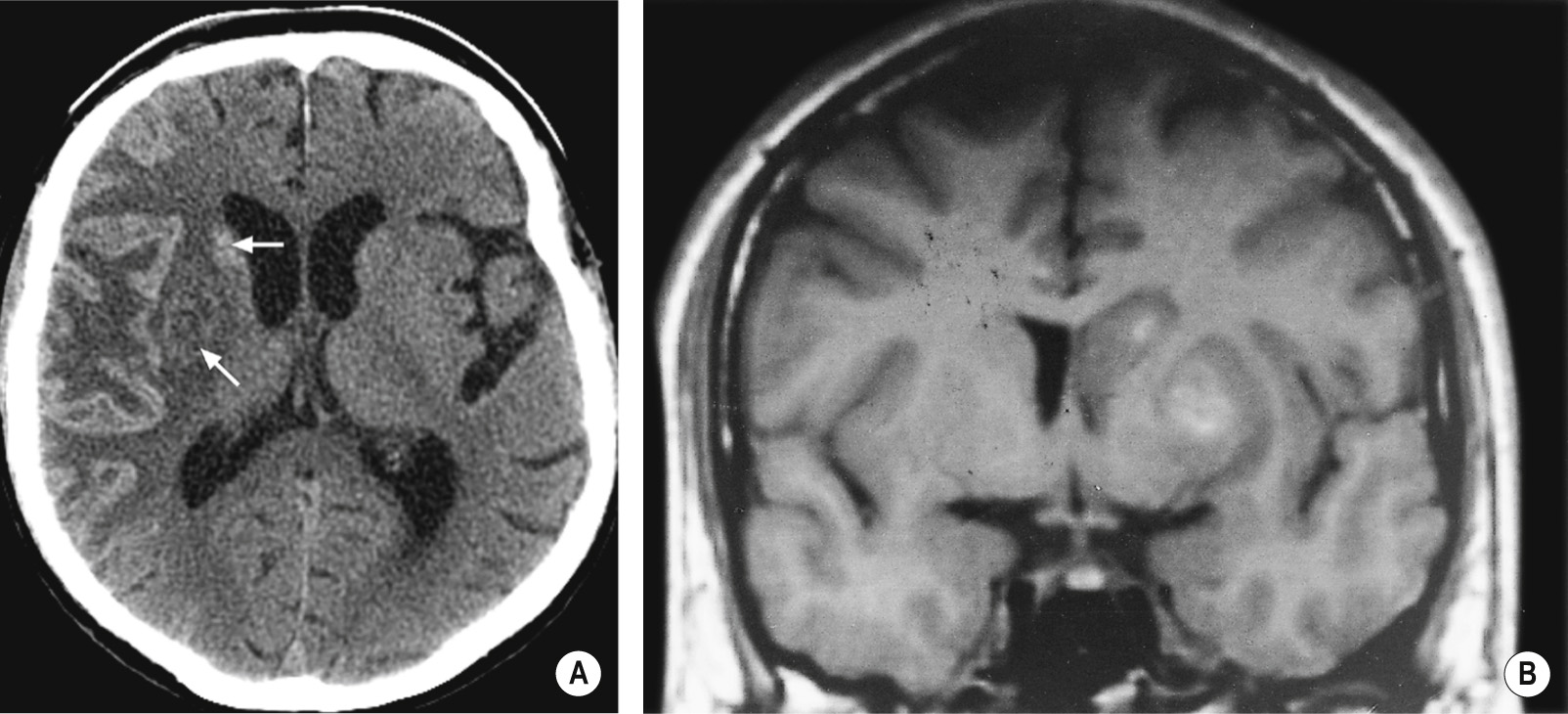
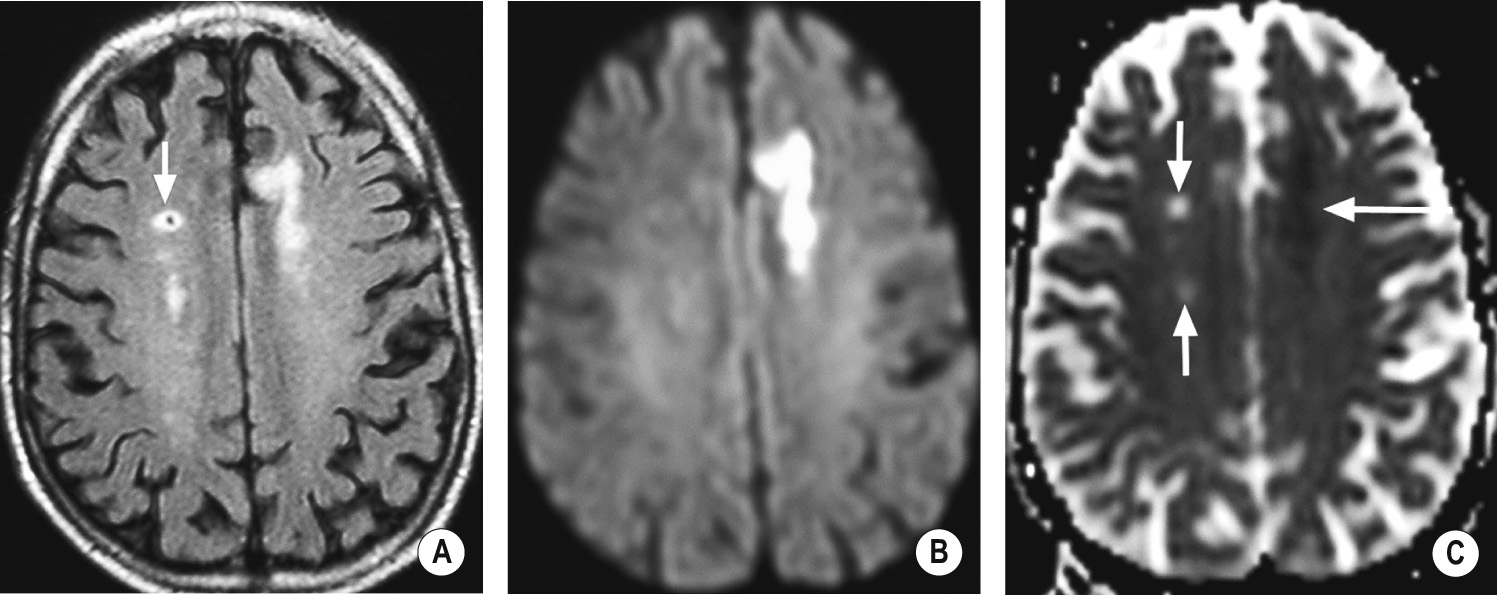
| T1WI | T2WI | DWI | ADC | |
|---|---|---|---|---|
| Hyperacute (0–6 h) | Isointense | Isointense | Bright | Dark |
| Acute (6 h to 4 days) | Hypointense (+ oedema mass effect) | Hyperintense (+ oedema mass effect) | Bright | Dark |
| Subacute (4–14 days) | Hypointense | Hyperintense | Dark (It may be bright secondary to T2 shine through) |
Pseudonormalization |
| Chronic | A smaller area of low intensity + encephalomalacia | Hyperintense | Hypointense Dark (It may be bright secondary to T2 shine through) |
Bright |
| Vasogenic oedema | Cytotoxic oedema | |
|---|---|---|
| Cause | Tumour ▸ abscess ▸ haemorrhage ▸ trauma | Ischaemia (e.g. stroke) |
| Mechanism | Disruption of the blood–brain barrier ▸ increased capillary endothelial permeability leads to fluid extravasation | Failure of membrane ATP-dependent sodium pumps ▸ accumulation of intracellular sodium and water |
| Imaging | Characteristic finger-like pattern with cortical sparing | Involvement of both cortex and white matter |
A normal variant seen in older people predominantly affecting the periventricular and deep cerebral white matter, basal ganglia and ventral pons ▸ it is due to arteriolar occlusion of the long penetrating arteries with the outcome dependent upon vessel size:
Large vessel: a lacunar infarct (with an associated cavity)
Small vessels: ischaemic demyelination and gliosis
It is usually clinically silent unless it arises within an eloquent area
Severe ischaemic damage is associated with cognitive impairment
Acute lacunar infarct: rounded with a hazy outline ▸ may fluctuate in size (enlarging)
Mature lacunar infarct: sharply delineated ▸ shrink in size (<1.5 cm) ▸ cavity like
Periventricular white matter hypodensities (leukoaraiosis)
T2WI: high SI within the white matter (FLAIR sequences are particularly sensitive) ▸ white matter changes are non-specific and can be encountered in vasculitis
This will confirm the site of an acute subcortical infarct even if there is widespread pre-existing ischaemic change
Microbleeds (foci of old haemorrhage) can occur with hypertensive small vessel and are a marker of vascular fragility ▸ small foci of susceptibility artefact on T2*GRE and SWI
Risk factors: age ▸ hypertension ▸ elevated haemoglobin levels ▸ diabetes ▸ smoking ▸ hyperlipidaemia
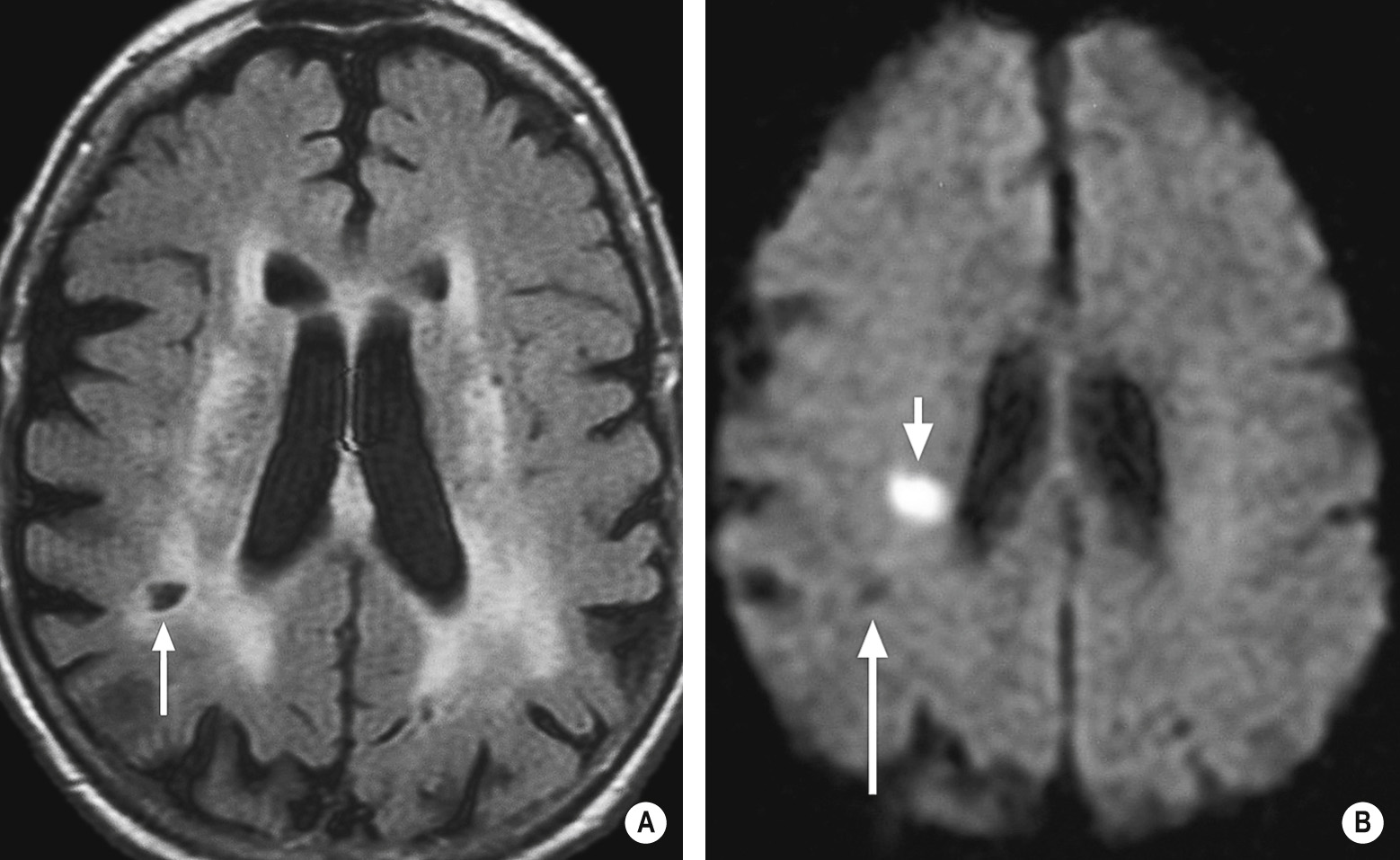
An idiopathic arteriopathy whereby dilated collateral vessels (particularly the lenticulostriate and thalamoperforator arteries) develop secondary to a progressive stenosis of the terminal internal carotid artery and its proximal intracranial segments (particularly the anterior circulation) ▸ primarily involves the supraclinoid ICAs, often progressing to the proximal anterior and middle cerebral arteries (occasionally the posterior circulation)
Moyamoya is Japanese for ‘puff of smoke’ (describing the angiographic appearance of the collateral vessels)
As well as being idiopathic it is associated with:
Sickle cell disease ▸ secondary to NF-1 ▸ cranial irradiation ▸ Down's syndrome ▸ HIV ▸ tuberculous meningitis
In post-infective angiitis associated with varicella zoster the terminal ICA and proximal MCA are usually affected and there is infarction of the basal ganglia
Abnormal dilated and irregular collateral vessels (± infarcts, usually in the border zones)
It accounts for up to 30% of the cerebral vasculopathy in paediatric stroke
External to internal carotid bypass
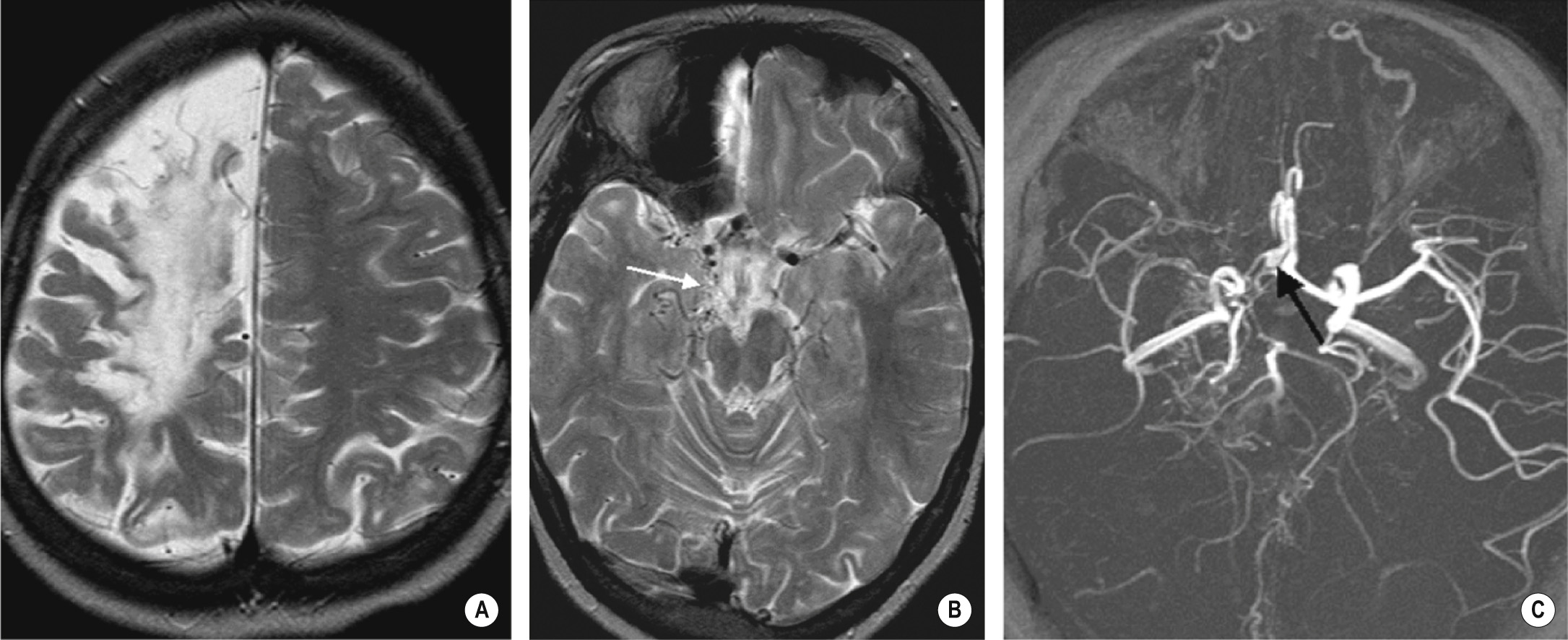
An inadequate oxygen supply due to severe hypotension or impaired blood oxygenation
Global hypoperfusion can result in watershed infarcts: these are wedge-shaped lesions within the frontal or parietal lobes at the junctions of the ACA/MCA and MCA/PCA arterial territories, respectively
Anoxia due to defective blood oxygenation (e.g. carbon monoxide poisoning) tends to cause infarcts within especially sensitive regions (e.g. the basal ganglia)
Become a Clinical Tree membership for Full access and enjoy Unlimited articles
If you are a member. Log in here